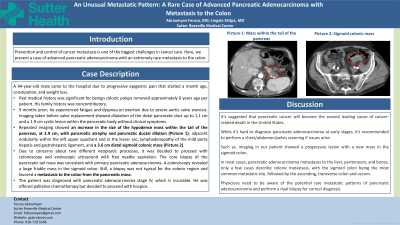Sunday Poster Session
Category: Biliary/Pancreas
P0092 - An Unusual Metastatic Pattern: A Rare Case of Advanced Pancreatic Adenocarcinoma With Metastasis to the Colon
Sunday, October 27, 2024
3:30 PM - 7:00 PM ET
Location: Exhibit Hall E

Has Audio

Feruza Abraamyan, MD
Sutter Health
Roseville, CA
Presenting Author(s)
Feruza Abraamyan, MD, Lingala Shilpa, MD
Sutter Health, Roseville, CA
Introduction: Prevention and control of cancer metastasis is one of the biggest challenges in cancer care. Here, we present a case of advanced pancreatic adenocarcinoma with an extremely rare metastasis to the colon.
Case Description/Methods: A 94-year-old male came to the hospital due to progressive epigastric pain that started a month ago, constipation, and weight loss. Past medical history was significant for benign colonic polyps removed approximately 6 years ago per patient. His family history was noncontributory. 9 months prior; he experienced fatigue and dyspnea on exertion due to severe aortic valve stenosis. Imaging taken before valve replacement showed dilatation of the distal pancreatic duct up to 1.1 cm and a 1.9 cm cystic lesion within the pancreatic body without clinical symptoms. Repeated imaging showed an increase in the size of the hypodense mass within the tail of the pancreas, at 2.9 cm, with pancreatic atrophy and pancreatic ductal dilation; adjacent nodularity within the left upper quadrant and in the lesser sac; lymphadenopathy of the mild porta hepatis and gastrohepatic ligament, and a 3.6 cm distal sigmoid colonic mass. Due to concerns about two different neoplastic processes, it was decided to proceed with colonoscopy and endoscopic ultrasound with free needle aspiration. The core biopsy of the pancreatic tail mass was consistent with primary pancreatic adenocarcinoma. A colonoscopy revealed a large friable mass in the sigmoid colon. Still, a biopsy was not typical for the colonic region and favored a metastasis to the colon from the pancreatic mass. The patient was diagnosed with pancreatic adenocarcinoma stage IV, which is incurable. He was offered palliative chemotherapy but decided to proceed with hospice.
Discussion: It's suggested that pancreatic cancer will become the second leading cause of cancer-related death in the United States. While it's hard to diagnose pancreatic adenocarcinoma at early stages, it's recommended to perform a chest/abdomen/pelvis scanning if issues arise. Such as imaging in our patient showed a progressive lesion with a new mass in the sigmoid colon. In most cases, pancreatic adenocarcinoma metastases to the liver, peritoneum, and bones; only a few cases describe colonic metastasis, with the sigmoid colon being the most common metastatic site, followed by the ascending, transverse colon and cecum. Physicians need to be aware of the potential rare metastatic patterns of pancreatic adenocarcinoma and perform a dual biopsy for correct diagnosis.
Disclosures:
Feruza Abraamyan, MD, Lingala Shilpa, MD. P0092 - An Unusual Metastatic Pattern: A Rare Case of Advanced Pancreatic Adenocarcinoma With Metastasis to the Colon, ACG 2024 Annual Scientific Meeting Abstracts. Philadelphia, PA: American College of Gastroenterology.
Sutter Health, Roseville, CA
Introduction: Prevention and control of cancer metastasis is one of the biggest challenges in cancer care. Here, we present a case of advanced pancreatic adenocarcinoma with an extremely rare metastasis to the colon.
Case Description/Methods: A 94-year-old male came to the hospital due to progressive epigastric pain that started a month ago, constipation, and weight loss. Past medical history was significant for benign colonic polyps removed approximately 6 years ago per patient. His family history was noncontributory. 9 months prior; he experienced fatigue and dyspnea on exertion due to severe aortic valve stenosis. Imaging taken before valve replacement showed dilatation of the distal pancreatic duct up to 1.1 cm and a 1.9 cm cystic lesion within the pancreatic body without clinical symptoms. Repeated imaging showed an increase in the size of the hypodense mass within the tail of the pancreas, at 2.9 cm, with pancreatic atrophy and pancreatic ductal dilation; adjacent nodularity within the left upper quadrant and in the lesser sac; lymphadenopathy of the mild porta hepatis and gastrohepatic ligament, and a 3.6 cm distal sigmoid colonic mass. Due to concerns about two different neoplastic processes, it was decided to proceed with colonoscopy and endoscopic ultrasound with free needle aspiration. The core biopsy of the pancreatic tail mass was consistent with primary pancreatic adenocarcinoma. A colonoscopy revealed a large friable mass in the sigmoid colon. Still, a biopsy was not typical for the colonic region and favored a metastasis to the colon from the pancreatic mass. The patient was diagnosed with pancreatic adenocarcinoma stage IV, which is incurable. He was offered palliative chemotherapy but decided to proceed with hospice.
Discussion: It's suggested that pancreatic cancer will become the second leading cause of cancer-related death in the United States. While it's hard to diagnose pancreatic adenocarcinoma at early stages, it's recommended to perform a chest/abdomen/pelvis scanning if issues arise. Such as imaging in our patient showed a progressive lesion with a new mass in the sigmoid colon. In most cases, pancreatic adenocarcinoma metastases to the liver, peritoneum, and bones; only a few cases describe colonic metastasis, with the sigmoid colon being the most common metastatic site, followed by the ascending, transverse colon and cecum. Physicians need to be aware of the potential rare metastatic patterns of pancreatic adenocarcinoma and perform a dual biopsy for correct diagnosis.
Disclosures:
Feruza Abraamyan indicated no relevant financial relationships.
Lingala Shilpa indicated no relevant financial relationships.
Feruza Abraamyan, MD, Lingala Shilpa, MD. P0092 - An Unusual Metastatic Pattern: A Rare Case of Advanced Pancreatic Adenocarcinoma With Metastasis to the Colon, ACG 2024 Annual Scientific Meeting Abstracts. Philadelphia, PA: American College of Gastroenterology.
